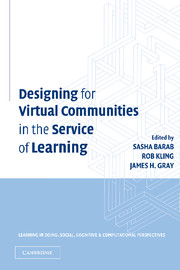Book contents
- Frontmatter
- Contents
- List of Contributors
- Series Foreword
- Foreword
- Preface and Acknowledgments
- In Memoriam
- PART I COMING TO TERMS WITH COMMUNITY
- 1 Introduction
- 2 Online Learning Communities
- PART II DESIGNING FOR WEB-SUPPORTED COMMUNITY
- PART III FOSTERING COMMUNITY/MEMBER PARTICIPATION
- PART IV RESEARCHING ONLINE COMMUNITY
- Index
- Titles in the series
- References
2 - Online Learning Communities
Common Ground and Critical Differences in Designing Technical Environments
Published online by Cambridge University Press: 05 June 2012
- Frontmatter
- Contents
- List of Contributors
- Series Foreword
- Foreword
- Preface and Acknowledgments
- In Memoriam
- PART I COMING TO TERMS WITH COMMUNITY
- 1 Introduction
- 2 Online Learning Communities
- PART II DESIGNING FOR WEB-SUPPORTED COMMUNITY
- PART III FOSTERING COMMUNITY/MEMBER PARTICIPATION
- PART IV RESEARCHING ONLINE COMMUNITY
- Index
- Titles in the series
- References
Summary
The psychological model we hold for the mind influences the way we think and act in designing and participating in intentional learning settings. Social and cognitive scientists have been expanding educational models of learning with their examinations of the distinctions between individual cognition and social cognition, promoting a conception of shared mind. Using terms such as collective sense-making, distributed intelligence, dialogue, group mind, systems thinking, or activity theory, they suggest a view of learning in which there is a shift in power relationships, a respect for practitioner knowledge, and an emphasis on group learning through intentional activity, collective reflection, and participatory decision-making. This view gives rise to a range of popular phrases in the field of education, including: learning communities, communities of learners, Learning Circles, learning organizations, knowledge communities, communities of practice, professional community, and learning organizations. These terms are attempts to characterize new forms of social/cultural learning. They are often used interchangeably, despite the fact that each evolves out of a different research tradition, thus highlighting different aspects of collaborative work and group structure.
Our objective in this chapter is to provide common language for understanding the different forms of social organization, goals, and outcomes of learning in communities. We suggest three distinct but overlapping forms of learning within communities (task-based, practice-based, and knowledge-based learning) and discuss practical design implications of these distinctions. In doing so, we keep a focus on how networked technologies support these variations in perspectives on collaborative work.
Information
- Type
- Chapter
- Information
- Publisher: Cambridge University PressPrint publication year: 2004
References
Accessibility standard: Unknown
Why this information is here
This section outlines the accessibility features of this content - including support for screen readers, full keyboard navigation and high-contrast display options. This may not be relevant for you.Accessibility Information
- 67
- Cited by
